This week’s Tutorial Tuesday post is a simple one, it’s hard to even call it a recipe. It requires very little work and it’s really hard to mess it up. You can make easily create your own signature vegetable stock with whatever your favorite ingredients are.
I find most store bought vegetable stocks to be lacking. They always taste flat and they all have this strange aftertaste, to me. I have never found one that I love. Most leave me wanting for more. I started making my own homemade vegetable stock a long time ago and it’s one of the easiest things you can make yourself at home. You can control the ingredients, the level of salt, the spices and it’s also a great way to use of vegetable scraps.
In the event you didn’t know, (I didn’t learn this until quite recently) there is a difference between a stock and a broth and that difference is usually just salt. Broth has salt added, stock does not. See, you learn something new every day. Actually, I think it is more than just the salt that makes them different, I believe that it’s seasoning in general, spices, salt, wine, etc. Essentially you are looking for a stock to be somewhat neutral in flavor, almost to where when you taste it, it’s missing a little something. Instead it’s about letting the dish the stock ultimately goes into dictate the spices and the levels of salt. Either way, I prefer to make a vegetable stock over a broth, so I can control the saltiness with each recipe I use it in. I do, however, still add simple, yet somewhat neutral spices, that will work with virtually any recipe my stock would go into.
This simple homemade vegetable stock can be made in your slow cooker with the greatest of ease. In fact, this is how I prefer to make it. It can easily be made on the stove top, as well. The recipe I share below is the general bare bones version of my vegetable stock, my simple, classic recipe that always works. But, depending on what I have on hand, I will add even more. This time around, I also included leeks. Often, I will include dried shiitake mushrooms or some seaweed for a little umami! For non-vegans, parmesan rinds are also great for a little extra umami goodness.
Be sure to check out the notes at the end to see some of my other tips and tricks!
[print_this]How-to Make Vegetable Stock
makes between 2 and 3 quarts
- 1 tablespoon Terra Delyssa Organic Extra Virgin Olive Oil, plus more to storing
- 2 large onions, peeled and quartered
- 4 to 6 cloves garlic, peeled
- 2 to 3 large carrots, cut into 1-inch pieces
- 3 to 4 celery stalks, cut into 1-inch pieces
- a few sprigs fresh thyme and/or rosemary
- 2 bay leaves
- 1 small bunch parsley
- 1 teaspoon whole peppercorns
- 3 quarts cold filtered water
Optional Extras: fennel, leeks (especially the green parts), tomatoes, dried or fresh mushrooms, parsnips, seaweed, kale, white wine or vermouth (add in the last 5 to 10 minutes of cooking), parmesan cheese rind
To make this a broth, rather than a stock, simply add about 2 teaspoons of high quality sea salt or you can also try 1-2 tablespoons coconut amino or gluten-free tamari sauce.
1) Add all of the ingredients to a 4-6 quart slow cooker. Add 3 quarts of cold water (I would recommend 4 or 5 quarts if using a 6 quart slow cooker). Cover and cook on low for about 10 hours. My slow cooker’s “low” is quite tame, so many times I cook my vegetable stock for more like 18 hours, to really get the best depth of flavor.
2) Turn off the heat, cool slightly, then strain. Let cool completely before transferring to airtight containers. I love using my 1 quart wide mouth mason jars or my swing top jars.
3) The vegetable stock can be stored in the refrigerator for up to a week or it can be frozen for up to 3 months in 1 quart containers, just be sure to leave 1-inch of head space for expansion.
Stove Top Directions: If you don’t have a slow cooker or wish to make this on the stove top, simply add all of the ingredients to a large stock pot, add the 3 quarts of water and bring to a very gentle boil. Reduce the heat to simmer and cook for about 1 1/2 hours.
[/print_this]NOTES:
- For a really deep, rich flavor, try roasting your vegetables first.
- Save your vegetable scraps, they make great additions to homemade stock. You can even make a pot of stock strictly from scraps, though I rarely do this since I am a control freak. Great options for scraps are the green parts of leeks, onion peels, the ends of carrot and/or the peels. Use skins, peels, stems, cores, ends, etc. Get creative.
- I keep scraps in the freezer until I am ready to make another batch of stock, then I pull them all out and dump them in.
- Use common sense, always adequately wash any vegetables before adding to your stock and never add anything you wouldn’t eat, straight up. So don’t add moldy or slimy bits, and definitely don’t add rotten or rancid veggies. If you are trimming off creepy soft brown spots, don’t turn around and add these to your stock. OK, I think you get it.
- Avoid potatoes or corn, as these give you a cloudy stock. Avoid beets as they give you pink stock.
- Boiling vegetable stock for a long time causes it to taste bitter, which is why the slow cooker is great. Low and slow. Slow and steady. All those things.
- Brussels sprouts, broccoli, cauliflower, asparagus, cabbage, artichokes and beets all tend towards creating a bitter broth. It’s not to say you cannot add them, I simply suggest that you just use very sparingly and add them near the end.
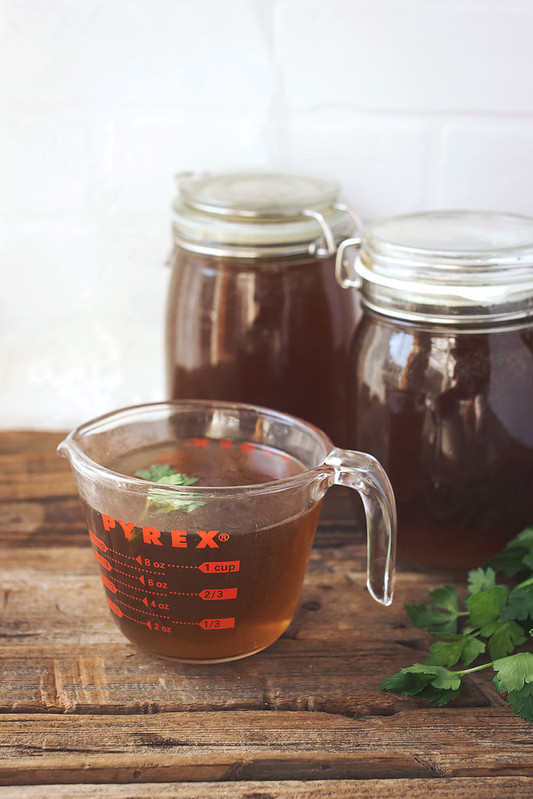
Terra Delyssa is a sponsor of Tasty Yummies. All content, ideas, and words are my own. Thanks for supporting the sponsors that allow me to create new and special content like this for Tasty Yummies.

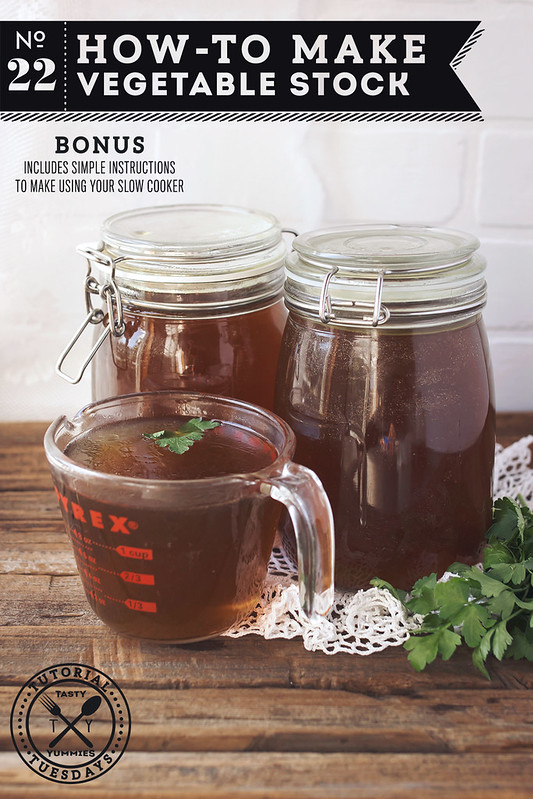
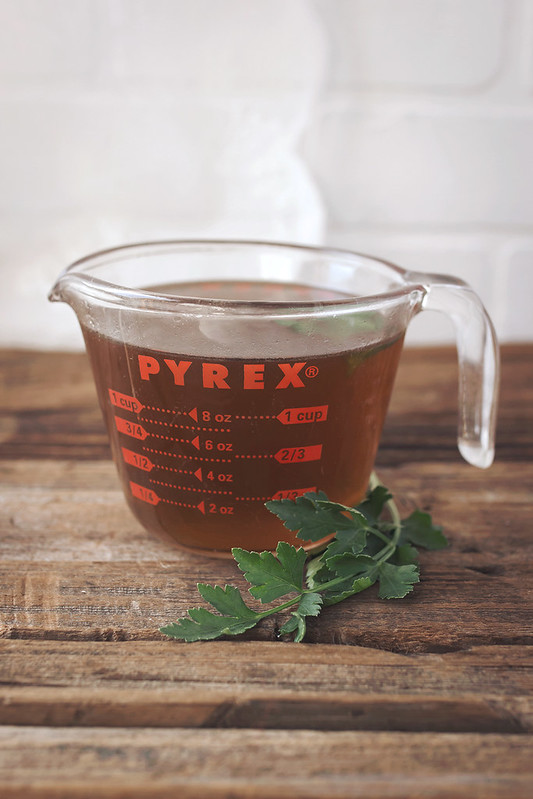
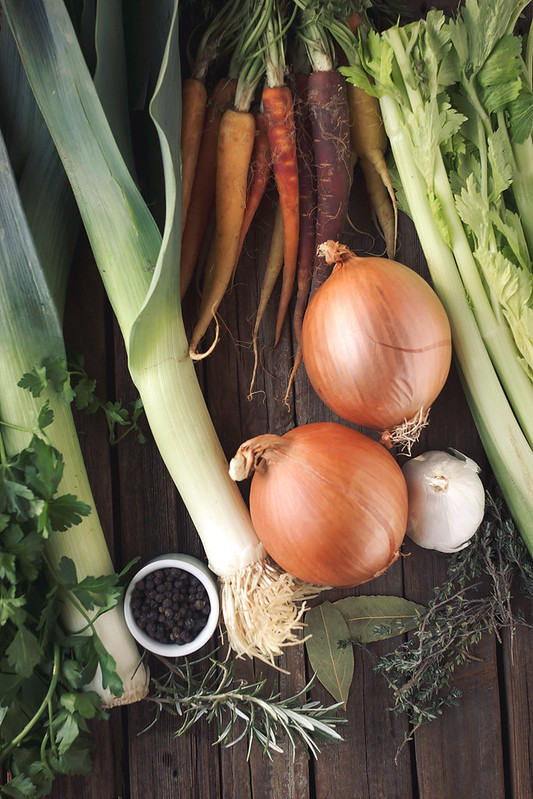
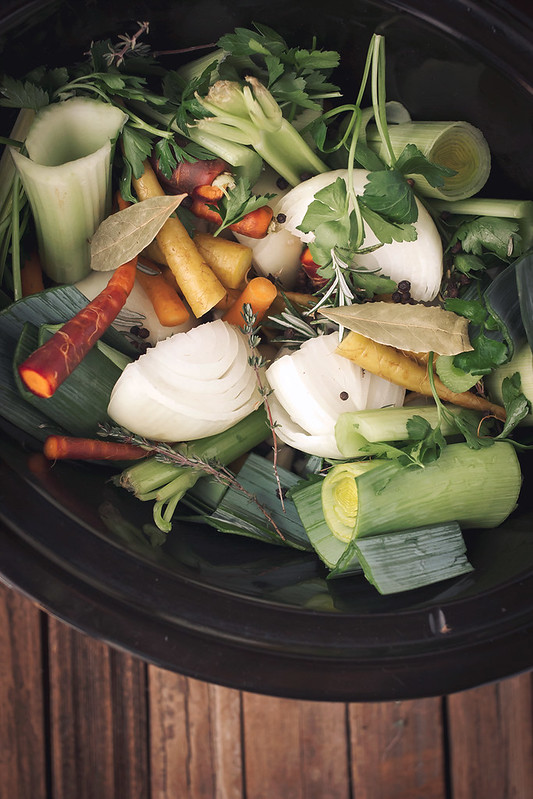
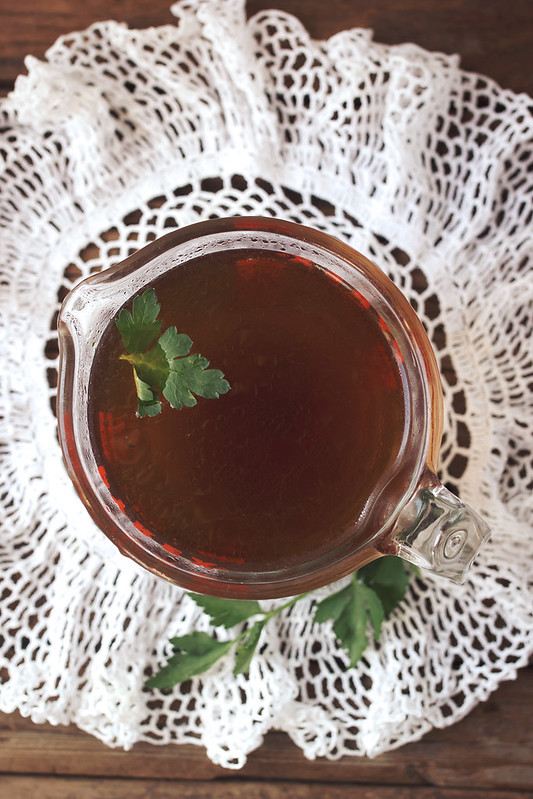
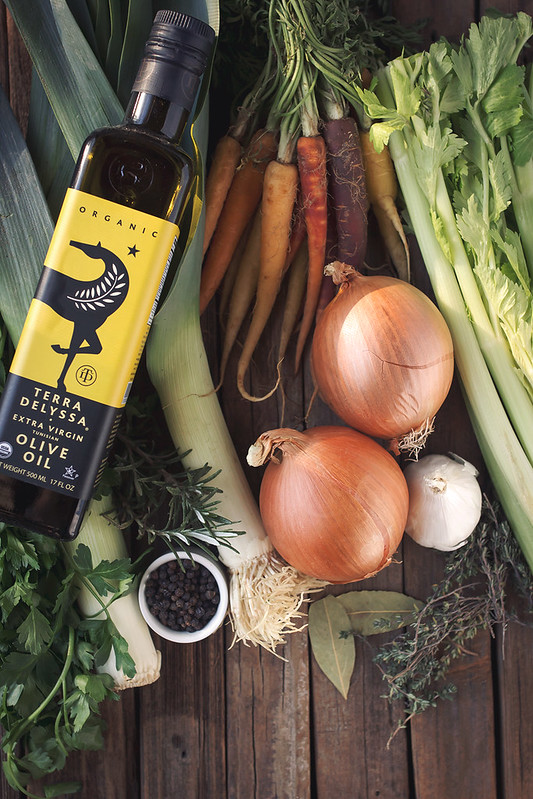



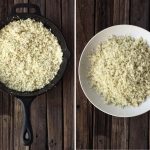


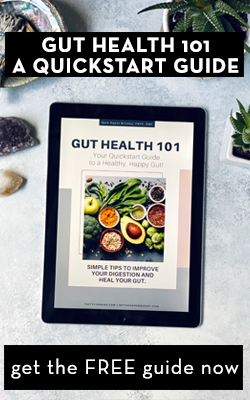




5 Responses
Thank you for this post.
I make my own broth(s) already, but those are meat (well, bone, anyway) based and I needed a vegetable version I could trust (vegetarian company coming and I want to make soup).
I DO trust your recipes, and I so love your tutorials. I am still making sprouts per your instruction – and, I never would have attempted that without you.
Thank you again for all the work that you do.
-Ouida
I never make the same stock recipe twice, and I can’t wait to give yours a shot! It looks great 🙂
All of your helpful hints are really great! I have enjoyed reading your blogs! I agree that salt is the ingredient that separates broth from stock. In culinary school we added a sachet d’epices (bay leaf, parsley, thyme, garlic cloves and peppercorns wrapped in cheesecloth) or a bouquet garni (same ingredients minus the cheesecloth and bound with twine instead) into our stocks. Our beef stock was made with red wine which we used for deglazing the pan after roasting the bones and the veggies and caramelizing the tomato paste (pincé).
I love this site and have put it on my favorites list. Your pictures and general layout is so pleasing. Thank you for your wonderful attention to detail. You are helping so many people with all that you do here. 🙂
I, too, began making my own broths/stocks – both veggie and chicken – and use crockpot. I rarely use beef so that is not on my agenda as a regular freezer item. I also will save all veggie scraps and keep a Ziploc bag in freezer to ad the scraps to for a future broth. I also use homemade chicken stock for my dog’s kibble to prevent kibble cough (expensive lesson after an emergency trip to vet because I thought he was dying – nope! Kibble Cough! WHAT???).
Thanks so much for this! Love your blog, been following here and there for about a year now and just want to say thank you!
For this recipe, I am assuming the veggies are still good for using in a soup after being used to make this broth? I am thinking if I make the broth then strain and add chicken with the veggies and season I could have some type of chicken soup? Or are the veggies pretty much all mush after cooking for 10+ hours?
Thanks!